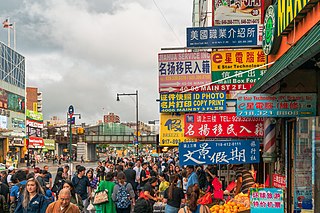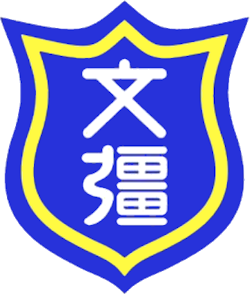
Chinatown is the catch-all name for an ethnic enclave of Chinese people located outside Greater China, most often in an urban setting. Areas known as "Chinatown" exist throughout the world, including Europe, Asia, Africa, Oceania, and the Americas.

Manhattan's Chinatown is a neighborhood in Lower Manhattan, New York City, bordering the Lower East Side to its east, Little Italy to its north, Civic Center to its south, and Tribeca to its west. With an estimated population of 90,000 to 100,000 people, Chinatown is home to the highest concentration of Chinese people in the Western Hemisphere. Manhattan's Chinatown is also one of the oldest Chinese ethnic enclaves. The Manhattan Chinatown is one of nine Chinatown neighborhoods in New York City, as well as one of twelve in the New York metropolitan area, which contains the largest ethnic Chinese population outside of Asia, comprising an estimated 893,697 uniracial individuals as of 2017.

Chinatown, Boston is a neighborhood located in downtown Boston, Massachusetts, United States. It is the only surviving historic ethnic Chinese enclave in New England since the demise of the Chinatowns in Providence, Rhode Island and Portland, Maine after the 1950s. Because of the high population of Asians and Asian Americans living in this area of Boston, there is an abundance of Chinese and Vietnamese restaurants located in Chinatown. It is one of the most densely populated residential areas in Boston and serves as the largest center of its East Asian and Southeast Asian cultural life.

Mott Street is a narrow but busy thoroughfare that runs in a north–south direction in the New York City borough of Manhattan. It is regarded as Chinatown's unofficial "Main Street". Mott Street runs from Bleecker Street in the north to Chatham Square in the south. It is a one-way street with southbound-running vehicular traffic only.
The Chinese Consolidated Benevolent Association (CCBA) is a historical Chinese association established in various parts of the United States and Canada with large Overseas Chinese communities. The association's clientele were Chinese immigrants of the late 19th and early 20th centuries, mainly from eight districts on the west side of the Pearl River Delta in Guangdong, southern China, and their descendants. The later wave of Chinese immigrants, after 1965, who came from a much wider area in China, did not experience the level of hostility faced by the pioneers and did not join the CCBA, which greatly lessened its influence.

I Wor Kuen was a radical Marxist Asian American collective that originally formed in 1969 in New York City's Chinatown. Borrowing from the ideologies of the Young Lords and the Black Panthers, IWK organized several community programs and produced a newsletter series promoting self-determination for Asian Americans. Initially consisting of students from Columbia University, the group worked in conjunction with residents of New York City's Chinatown to address the community's needs for healthcare reform, draft counseling, and childcare. The group expanded nationally with the Red Guard Party in San Francisco in 1972 to create a national organisation.
The Hip Sing Association or HSA, formerly known as the Hip Sing Tong, is a Chinese-American criminal organization/gang formed as a labor organization in New York City's Chinatown during the early 20th century. The Cantonese name "Hip Sing" translates roughly to "cooperating for success." The Hip Sing Tong, along with their rivals the Four Brothers and the On Leong Tong, would be involved in violent Tong wars for control of Chinatown during the early 1900s. During the 1930s and 1940s, the Hip Sings were involved in drug trafficking operations with the Kuomintang (KMT) and later the Office of Policy Coordination (OPC). They would later establish chapters in Chinese-American communities throughout the United States in major cities such as Chicago, Seattle and San Francisco. Recently some branches have begun to transform back into the legitimate fraternal organization they started as over a century prior.

The first Brooklyn Chinatown, was originally established in the Sunset Park area of the New York City borough of Brooklyn. It is one of the largest and fastest growing ethnic Chinese enclaves outside of Asia, as well as within New York City itself. Because this Chinatown is rapidly evolving into an enclave predominantly of Fuzhou immigrants from Fujian Province in China, it is now increasingly common to refer to it as the Little Fuzhou or Fuzhou Town of the Western Hemisphere; as well as the largest Fuzhou enclave of New York City.
The Chinese Benevolent Association of Vancouver (CBA) is a Chinese Canadian organization headquartered in Vancouver. It serves as a federation of various Vancouver-based Chinese organizations. Douglas Aitken of The Georgia Straight stated that the CBA was the most important organization operating in the Vancouver Chinatown in the first half of the 20th century. The Vancouver Sun wrote "They were, for all intents and purposes, the government of Chinatown." According to The New York Times, the organization was a longtime supporter of Taiwan until the 1980s when it shifted to a pro-Beijing position.

The New York metropolitan area is home to the largest and most prominent ethnic Chinese population outside of Asia, hosting Chinese populations representing all 34 provincial-level administrative units of China. The Chinese American population of the New York City metropolitan area was an estimated 893,697 as of 2017, constituting the largest and most prominent metropolitan Asian national diaspora outside Asia. New York City itself contains by far the highest ethnic Chinese population of any individual city outside Asia, estimated at 628,763 as of 2017.
The Chicago metropolitan area has an ethnic Chinese population. While historically small in comparison to populations on the coasts, the community is rapidly expanding. As of 2023, there are 78,547 Chinese Americans who live in Chicago, comprising 2.9% of the city's population, along with over 150,000 Chinese in the greater Chicago area - making Chicago's Chinese community the 8th largest among US metropolitan areas. This population includes native-born Chinese as well as immigrants from Mainland China, Taiwan, Hong Kong and Southeast Asia, and also racially mixed Chinese.

There are multiple Chinatowns in the borough of Queens in New York City. The original Queens Chinatown emerged in Flushing, initially as a satellite of the original Manhattan Chinatown, before evolving its own identity, surpassing in scale the original Manhattan Chinatown, and subsequently, in turn, spawning its own satellite Chinatowns in Elmhurst, Corona, and eastern Queens. As of 2023, illegal Chinese immigration to New York has accelerated, and its Flushing neighborhood has become the present-day global epicenter receiving Chinese immigration as well as the international control center directing such migration. As of 2024, a significant new wave of Chinese Muslims is fleeing religious persecution in northwestern China’s Xinjiang Province and seeking religious freedom in New York, and concentrating in Queens.

The Chinese Canadian community in the Greater Toronto Area was first established around 1877, with an initial population of two laundry owners. While the Chinese Canadian population was initially small in size, it dramatically grew beginning in the late 1960s due to changes in immigration law and political issues in Hong Kong. Additional immigration from Southeast Asia in the aftermath of the Vietnam War and related conflicts and a late 20th century wave of Hong Kong immigration led to the further development of Chinese ethnic enclaves in the Greater Toronto Area. The Chinese established many large shopping centres in suburban areas catering to their ethnic group. There are 679,725 Chinese in the Greater Toronto Area as of the 2021 census, second only to New York City for largest Chinese community in North America.

The history of Chinese Canadians in British Columbia began with the first recorded visit by Chinese people to North America in 1788. Some 30–40 men were employed as shipwrights at Nootka Sound in what is now British Columbia, to build the first European-type vessel in the Pacific Northwest, named the North West America. Large-scale immigration of Chinese began seventy years later with the advent of the Fraser Canyon Gold Rush of 1858. During the gold rush, settlements of Chinese grew in Victoria and New Westminster and the "capital of the Cariboo" Barkerville and numerous other towns, as well as throughout the colony's interior, where many communities were dominantly Chinese. In the 1880s, Chinese labour was contracted to build the Canadian Pacific Railway. Following this, many Chinese began to move eastward, establishing Chinatowns in several of the larger Canadian cities.

Chinese Canadians are a sizable part of the population in Greater Vancouver, especially in the Chinese communities in the city of Vancouver and the adjoining suburban city of Richmond. The legacy of Chinese immigration is prevalent throughout the Vancouver area.

Chinatown Gateway is an outdoor paifang and sculpture which serves as an entrance to Portland, Oregon's Old Town Chinatown neighborhood, in the United States. The gate was proposed by the Chinese Consolidated Benevolent Association in 1984. Architect Yu Tang Wang and artist Sun Chau completed the gate's design, which was built by Ting Hwa Architects in Taiwan. It was then shipped to Portland and installed in one week before being dedicated in November 1986. It cost $256,000 and was the largest of its kind in the United States until one in Washington, D.C. was completed several months later.

Mon Keang School is a Chinese school located inside the Wongs' Benevolent Association Building at 123A East Pender Street, in the Chinatown of Vancouver, British Columbia, Canada. Classes have historically been taught in Cantonese, the prestige variety of Yue Chinese.

The Chinese Consolidated Benevolent Association and Victoria Chinese Public School Chinese: (中華會館和域多利華僑公立學校) is a historic building located in the downtown core of Victoria, British Columbia, Canada.
Association of Chinese Schools was founded by Prof. Peter P.C. Chou and six schools in Philadelphia in 1974. The goals are to provide a forum for Chinese language and culture schools to share their common interests, to exchange views and ideas, to assist school activities, to improve the quality of teaching, to promote Chinese teaching into the mainstream American education system. The Association of Chinese Schools is a non-profit, non-political independent organization. The organization was founded with 6 member schools and has grown to 56 member schools. The Association is a member of the Consortium for Language Teaching & Learning from the University of Maryland's National Foreign Language Center.
New York City is home to the second-largest Taiwanese American population, after the Los Angeles metropolitan area, California, enumerating an estimated 40,000 to 50,000 individuals as of 2020.















